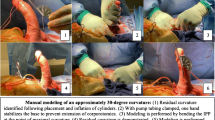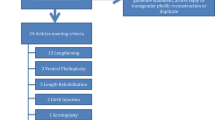Abstract
Purpose of Review
The use of penile implant for the treatment of both erectile dysfunction and Peyronie’s disease has changed little in the last 40 years, primarily limited to modeling and plaque incision. In the current review, I explore the history of Peyronie’s treatment at the time of penile prosthesis placement and explore new surgical options that help resolve several of the issues that were not treated with the traditional approaches.
Recent Findings
Advancements have been made in the area of graft material, lengthening procedures, and transcorporal techniques. The goal of these operations is not only to correct curvature, but also to restore length. Not surprisingly, the more complex and aggressive the attempt to correct the curvature, the more complications are possible. While modeling has a low rate of urethral injury, complex lengthening procedure with neurovascular bundle and urethral mobilization may lead to the dreaded complication of glans necrosis. Meanwhile, transcorporal techniques seem to offer a more modest improvement for length and curvature restoration with fewer risks than those seen in more aggressive lengthening procedures.
Summary
The main limitation to the historical treatment of Peyronie’s disease during penile prosthesis, modeling, and plaque incision is there is often no resolution to the penile length—as the maneuvers are made after the implant is already in place. Newer lengthening procedures are promising, however carry increased risks and complexity.
Similar content being viewed by others
References
Mulhall J, Ahmed A, Anderson M. Penile prosthetic surgery for Peyronie’s disease: defining the need for intraoperative adjuvant maneuvers. J Sex Med. 2004;1(3):318–21.
Levine LA, Benson J, Hoover C. Inflatable penile prosthesis placement in men with Peyronie’s disease and drug-resistant erectile dysfunction: a single-center study. J Sex Med. 2010;7(11):3775–83.
Raz S, Dekernion JB, Kaufman JJ. Surgical treatment of Peyronie’s disease: a new approach. J Urol. 1977;117(5):598–601.
Wilson SK, Delk JR 2nd. A new treatment for Peyronie’s disease: modeling the penis over an inflatable penile prosthesis. J Urol. 1994;152(4):1121–3.
Rahman NU, Carrion RE, Bochinski D, Lue TF. Combined penile plication surgery and insertion of penile prosthesis for severe penile curvature and erectile dysfunction. J Urol. 2004;171(6 Pt 1):2346–9.
Montorsi F, Guazzoni G, Barbieri L, Maga T, Rigatti P, Graziottin A, et al. AMS 700 CX inflatable penile implants for Peyronie’s disease: functional results, morbidity and patient-partner satisfaction. Int J Impot Res. 1996;8(2):81–5 discussion 5-6.
Levine LA, Burnett AL. Standard operating procedures for Peyronie’s disease. J Sex Med. 2013;10(1):230–44.
Levine LA, Dimitriou RJ. A surgical algorithm for penile prosthesis placement in men with erectile failure and Peyronie’s disease. Int J Impot Res. 2000;12(3):147–51.
Garaffa G, Minervini A, Christopher NA, Minhas S, Ralph DJ. The management of residual curvature after penile prosthesis implantation in men with Peyronie’s disease. BJU Int. 2011;108(7):1152–6.
Wilson SK, Cleves MA, Delk JR 2nd. Long-term followup of treatment for Peyronie’s disease: modeling the penis over an inflatable penile prosthesis. J Urol. 2001;165(3):825–9.
Mulcahy JJ, Wilson SK. Management of Peyronie’s disease with penile prostheses. Int J Impot Res. 2002;14(5):384–8.
Chung E, Solomon M, DeYoung L, Brock GB. Comparison between AMS 700 CX and Coloplast Titan inflatable penile prosthesis for Peyronie’s disease treatment and remodeling: clinical outcomes and patient satisfaction. J Sex Med. 2013;10(11):2855–60.
Mulhall J, Anderson M, Parker M. A surgical algorithm for men with combined Peyronie’s disease and erectile dysfunction: functional and satisfaction outcomes. J Sex Med. 2005;2(1):132–8.
Montague DK, Angermeier KW, Lakin MM, Ingleright BJ. AMS 3-piece inflatable penile prosthesis implantation in men with Peyronie’s disease: comparison of CX and Ultrex cylinders. J Urol. 1996;156(5):1633–5.
Segal RL, Burnett AL. Surgical management for Peyronie’s disease. The world journal of men's health. 2013;31(1):1–11.
Wilson SK, Cleves MA, Delk JR 2nd. Ultrex cylinders: problems with uncontrolled lengthening (the S-shaped deformity). J Urol. 1996;155(1):135–7.
Hudak SJ, Morey AF, Adibi M, Bagrodia A. Favorable patient reported outcomes after penile plication for wide array of Peyronie disease abnormalities. J Urol. 2013;189(3):1019–24.
Hatzichristodoulou G, Gschwend JE, Lahme S. Surgical therapy of Peyronie’s disease by partial plaque excision and grafting with collagen fleece: feasibility study of a new technique. Int J Impot Res. 2013;25(5):183–7.
Hatzichristodoulou G. The PICS technique: a novel approach for residual curvature correction during penile prosthesis implantation in patients with severe Peyronie’s disease using the collagen fleece TachoSil. J Sex Med. 2018;15(3):416–21.
Falcone M, Preto M, Ceruti C, Timpano M, Garaffa G, Sedigh O, et al. A comparative study between 2 different grafts used as patches after plaque incision and inflatable penile prosthesis implantation for end-stage Peyronie’s disease. J Sex Med. 2018;15(6):848–52.
Shaeer O. Trans-corporal incision of Peyronie’s plaques. J Sex Med. 2011;8(2):589–93.
Perito P, Wilson S. The Peyronie’s plaque "scratch": an adjunct to modeling. J Sex Med. 2013;10(5):1194–7.
Antonini G, De Berardinis E, Del Giudice F, Busetto GM, Lauretti S, Fragas R, et al. Inflatable penile prosthesis placement, scratch technique and postoperative vacuum therapy as a combined approach to definitive treatment of Peyronie’s disease. J Urology. 2018.
Sansalone S, Garaffa G, Djinovic R, Egydio P, Vespasiani G, Miano R, et al. Simultaneous penile lengthening and penile prosthesis implantation in patients with Peyronie’s disease, refractory erectile dysfunction, and severe penile shortening. J Sex Med. 2012;9(1):316–21.
Egydio PH, Kuehhas FE, Sansalone S. Penile length and girth restoration in severe Peyronie’s disease using circular and longitudinal grafting. BJU Int. 2013;111(4 Pt B):E213–9.
Rolle L, Ceruti C, Timpano M, Sedigh O, Destefanis P, Galletto E, et al. A new, innovative, lengthening surgical procedure for Peyronie’s disease by penile prosthesis implantation with double dorsal-ventral patch graft: the "sliding technique". J Sex Med. 2012;9(9):2389–95.
Rolle L, Falcone M, Ceruti C, Timpano M, Sedigh O, Ralph DJ, et al. A prospective multicentric international study on the surgical outcomes and patients’ satisfaction rates of the ‘sliding’ technique for end-stage Peyronie’s disease with severe shortening of the penis and erectile dysfunction. BJU Int. 2016;117(5):814–20.
Egydio PH, Kuehhas FE. Penile lengthening and widening without grafting according to a modified ‘sliding’ technique. BJU Int. 2015;116(6):965–72.
Egydio PH, Kuehhas FE, Valenzuela RJ. Modified sliding technique (MoST) for penile lengthening with insertion of inflatable penile prosthesis. J Sex Med. 2015;12(5):1100–4.
Egydio PH, Kuehhas FE. The multiple-slit technique (MUST) for penile length and girth restoration. J Sex Med. 2018;15(2):261–9.
Wilson SK, Mora-Estaves C, Egydio P, Ralph D, Habous M, Love C, et al. Glans necrosis following penile prosthesis implantation: prevention and treatment suggestions. Urology. 2017;107:144–8.
Author information
Authors and Affiliations
Corresponding author
Ethics declarations
Conflict of Interest
Jonathan Nicholas Warner is a consultant for Coloplast and Olympus.
Human and Animal Rights and Informed Consent
This article does not contain any studies with human or animal subjects performed by any of the authors.
Additional information
Publisher’s Note
Springer Nature remains neutral with regard to jurisdictional claims in published maps and institutional affiliations.
This article is part of the Topical Collection on Surgery
Rights and permissions
About this article
Cite this article
Warner, J.N. A Contemporary Evaluation of Peyronie’s Disease During Penile Prosthesis Placement: MOST, MUST, and More. Curr Urol Rep 20, 9 (2019). https://doi.org/10.1007/s11934-019-0870-z
Published:
DOI: https://doi.org/10.1007/s11934-019-0870-z




